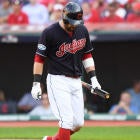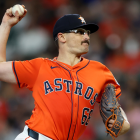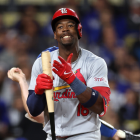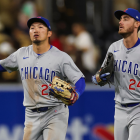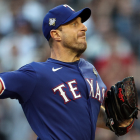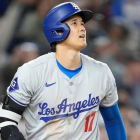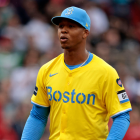Cleveland was supposed to run away with the American League Central, but instead it entered Tuesday with a 26-27 record and a 10-game deficit. It's safe to say they're in trouble. There's enough season remaining to envision Cleveland getting back in the race, but it won't come quickly and it won't be easy. Westgate, for instance, has lowered their championship odds to 25/1 on Tuesday. SportsLine has lowered their postseason odds to 8.9 percent (1.3 percent probability to win the AL Central). What was once inevitable is now improbable.
Sometimes it isn't enough to emphasize that this team and its front office were handcuffed by ownership who prioritized profits to winning; sometimes we want to explore ways in which the team can make the most of its situation. So, that's what we've done below, highlighting three ways Cleveland can maximize what it has on hand that doesn't involve anything outlandish or idyllic (e.g. "fix what ails Jose Ramirez"; or "get healthy"; or "trade for Anthony Rendon").
1. Move Kipnis down in the order
Cleveland exited Memorial Day tied with the Toronto Blue Jays for 26th in adjusted weighted runs created. It's never a good sign when you're neck-and-neck with a team who has repeatedly triggered no-hit watches, and it's also not a good sign when six of the 10 players you've given at least 75 plate appearances to have OPS+ of 75 or worse. Terry Francona has had, essentially, four productive players to build around: Carlos Santana, Francisco Lindor, Jordan Luplow and Roberto Perez, who entered the season with a reputation for being a mitt-first catcher.
Neither Jason Kipnis nor Jose Ramirez are listed above -- that despite being Cleveland's primary No. 2- and 3-hole hitters this season. In Ramirez's case, his deployment tells the story. He entered the season slotted in at No. 3, but his prolonged struggles caused Francona to drop him to fifth. Ideally, Francona could move Ramirez down further, but again: Cleveland has limited options at its disposal.
The "limited options" excuse is harder to buy as legitimate when it comes to Kipnis.
Rafael Devers is blazing hot at the plate, batting .452 across his seven-game hit streak. Jason Kipnis, meanwhile, is averaging just .174 at the plate in his last six games.
— NESN (@NESN) May 27, 2019
Check out how the two stack up in today's @Rodenhiser Heat Zone! pic.twitter.com/15GOx4YCpA
Prior to Sunday, Kipnis had batted second in every game he had started dating back to early May. On Sunday, Francona finally moved him down … to fourth. Past studies have indicated the most important spots in the lineup are the No. 1, 2, and 4 positions. Kipnis, whose OPS+ ranks sixth out of the eight qualified hitters on the team, is decidedly unfit to hold any of those slots.
This isn't a Ramirez situation, where Kipnis has shown reason for optimism. He hasn't finished with an OPS+ over 90 since 2016. His on-base percentage since then is .305. He's been an important part of the franchise for a while, but there's an ample amount of evidence -- nearly 1,200 plate appearances' worth -- suggesting he's a well-below-average hitter who should be dropped further down the lineup.
Outside of the soft factors, it's not clear why Francona continues to prioritize Kipnis. And while this isn't 2003 and we understand that batting order isn't that big of a deal, it strikes us as a suboptimal strategy at a time when Cleveland needs to be doing everything it can to score.
2. Give Bradley a chance
No team has received less production from the DH position this season than Cleveland. That's not surprising when you consider the personnel at hand: Hanley Ramirez and Carlos Gonzalez were well past their primes and proved as much before being designated for assignment, while young Jake Bauers has thus far failed to live up to expectations after being acquired in an offseason trade with the Tampa Bay Rays. If there's a bright side for Cleveland, it's that they do have another youngster to trot out there: former third-rounder Bobby Bradley.
Bradley, 23 come Wednesday, is hitting .275/.353/.569 with 12 home runs in Triple-A. While he has impressive raw power -- and has seemingly done a better job of applying it in-game -- there are legitimate reasons for concern about his viability in the majors. He's striking out more than a third of the time against Triple-A pitching -- a rate that will likely increase once he's exposed to big-league pitcher and game plans. That tendency, in turn, is likely to limit him to being a streaky walk-and-bop hitter who offers little value on the basepaths or in the field -- or, a DH, basically.
Shaky long-term evaluations aside, Bradley is hitting and that's more than what most of Cleveland's roster can say. By giving Bradley a look at DH, Cleveland could potentially upgrade a weak point while also getting a look at a potentially useful young player.
3. Play Mercado every day
To Cleveland's credit, starting Oscar Mercado as often as possible appears to be the plan now after a weird introduction to the majors where he received the nod once in his first three games. Nonetheless, permit us the opportunity to voice our support for the approach.
Mercado hit .294/.396/.496 in Triple-A this season, and has taken well to the majors in a small sample by batting .323/.417/.516. League sources had informed CBS Sports that Mercado had posted a higher launch angle and exit velocity in the minors than in previous years. Those trends have held true in the majors, which is an encouraging sign given the accompanying power production.
Oscar Mercado recorded his 1st Major League hit, and we can't emphasize just how *quickly* he scored. ⚡️#RallyTogether pic.twitter.com/rr2KEUp3sN
— Cleveland Indians (@Indians) May 18, 2019
Previously, the hope with Mercado had been that he would grow into an Ender Inciarte-like hitter who could provide a healthy average and tear it up on the basepaths and in center field. If those power gains prove genuine, then that adds a new dimension to his game -- one that could make him a dynamic all-around player.
Obviously it's too early to say for sure, but Cleveland needs to find out what Mercado can do -- and that means playing him as often as possible.
Those three suggestions are unlikely to change Cleveland's trajectory in any great way. But they would seemingly improve upon the current formula. Given the financial limitations put into place by ownership, that's about all Cleveland can ask for right now.













